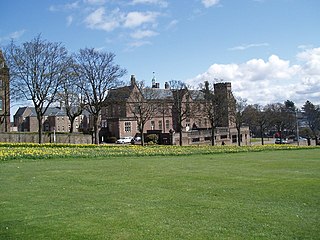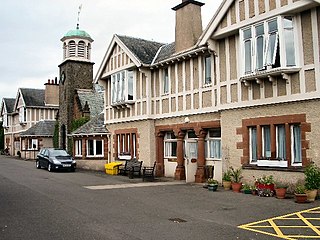
Perth and Kinross is one of the 32 council areas of Scotland and a Lieutenancy Area. It borders onto the Aberdeenshire, Angus, Argyll and Bute, Clackmannanshire, Dundee, Fife, Highland and Stirling council areas. Perth is the administrative centre. With the exception of a large area of south-western Perthshire, the council area mostly corresponds to the historic counties of Perthshire and Kinross-shire.

Blairgowrie and Rattray is a twin burgh in Perth and Kinross, Scotland. Locals refer to the town as "Blair". Blairgowrie is the larger of the two former burghs which were united by an Act of Parliament in 1928 and lies on the southwest side of the River Ericht while Rattray is on the northeast side. Rattray claims to be the older and certainly Old Rattray, the area round Rattray Kirk, dates back to the 12th century. New Rattray, the area along the Boat Brae and Balmoral Road dates from 1777 when the River was spanned by the Brig o' Blair. The town lies on the north side of Strathmore at the foot of the Grampian Mountains. The west boundary is formed by the Knockie, a round grassy hill, and Craighall Gorge on the Ericht. Blairgowrie and Rattray developed over the centuries at the crossroads of several historic routes with links from the town to Perth, Coupar Angus, Alyth and Braemar. The roads to Coupar Angus and Braemar form part of General Wade's military road from Perth to Fort George. The town's centrepiece is the Wellmeadow, a grassy triangle in the middle of town which hosts regular markets and outdoor entertainment.
Dundee is the fourth-largest city in Scotland with a population of around 150,000 people. It is situated on the north bank of the Firth of Tay on the east coast of the Central Lowlands of Scotland. The Dundee area has been settled since the Mesolithic with evidence of Pictish habitation beginning in the Iron Age. During the Medieval Era the city became a prominent trading port and was the site of many battles. Throughout the Industrial Revolution, the local jute industry caused the city to grow rapidly. In this period, Dundee also gained prominence due to its marmalade industry and its journalism, giving Dundee its epithet as the city of "jute, jam and journalism".

Ninewells Hospital is a large teaching hospital, based on the western edge of Dundee, Scotland. It is internationally renowned for introducing laparoscopic surgery to the UK as well as being a leading centre in developing fields such as the management of cancer, medical genetics and robotic surgery. Within the UK, it is also a major NHS facility for psychosurgery. The medical school was ranked first in the UK in 2009. The hospital has nursing and research links with the University of Dundee and is managed by NHS Tayside.

Hillside is a village in Angus, Scotland, situated 1 mile to the north of Montrose. The village is the location for the now disused psychiatric hospital, Sunnyside Royal Hospital. The hospital which was founded by Susan Carnegie in 1781 as the Montrose Lunatic Asylum, Infirmary and Dispensary had originally been situated on Montrose links. It moved out of the town to new premises at Hillside on lands that were part of Sunnyside farm in 1858. The hospital was expanded several times thereafter, before finally closing in 2011.

Sunnyside Royal Hospital was a psychiatric hospital located in Hillside, north of Montrose, Scotland. It closed in 2011 and is now used for housing.

NHS Tayside is an NHS board which forms one of the fourteen regions of NHS Scotland. It provides healthcare services in Angus, the City of Dundee and Perth and Kinross. NHS Tayside is headquartered at Ninewells Hospital in Dundee. It currently has one of the largest hospitals in the world and also one of the largest teaching hospitals in the world within its boundaries.
The Perth and Dunkeld Railway was a Scottish railway. It was built from Stanley Junction on the Scottish Midland Junction Railway to Birnam, on the opposite bank of the River Tay to Dunkeld.

The Crichton is an institutional campus in Dumfries in southwest Scotland. It serves as a remote campus for the University of Glasgow, the University of the West of Scotland, Dumfries and Galloway College, and the Open University. The site also includes a hotel and conference centre, and Crichton Memorial Church, set in a 100-acre (40 ha) park. The campus was established in the 19th century as the Crichton Royal Hospital, a psychiatric hospital.
Perth is a city and former royal burgh in central Scotland. There has been a settlement at Perth since prehistoric times. Finds in and around Perth show that it was occupied by the Mesolithic hunter-gatherers who arrived in the area more than 8,000 years ago. Nearby Neolithic standing stones and circles followed the introduction of farming from about 4000 BC, and a remarkably well preserved Bronze Age log boat dated to around 1000 BC was found in the mudflats of the River Tay at Carpow to the east of Perth. Carpow was also the site of a Roman legionary fortress.

Arbroath Infirmary is a hospital at the top of Rosemount Road in Arbroath serving the town and the greater area of Angus, Scotland. The hospital is managed by NHS Tayside.

Murthly is a village in Perth and Kinross, Scotland. It lies on the south bank of the River Tay, 5 miles southeast of Dunkeld, and 9+1⁄2 miles north of Perth. Perth District Asylum, later known as Murthly Hospital, was opened in the village on 1 April 1864 for 'pauper lunatics'. It was the second district asylum to be built in Scotland under the terms of the 1857 Lunacy (Scotland) Act. It closed in 1984 and was later demolished. The village has a stone circle, in the former grounds of the hospital. The village formerly had a railway station on the Perth and Dunkeld Railway, which closed in 1965.

Dundee Royal Infirmary, often shortened to DRI, was a major teaching hospital in Dundee, Scotland. Until the opening of Ninewells Hospital in 1974, Dundee Royal Infirmary was Dundee's main hospital. It was closed in 1998, after 200 years of operation.

Maryfield Hospital was a hospital in Stobswell, Dundee, Scotland. Originally a poorhouse hospital it became Dundee's second main hospital after Dundee Royal Infirmary. It closed in the 1970s following the opening of Ninewells Hospital.

King's Cross Hospital, often shortened to King's Cross is a hospital in Dundee, Scotland. It is managed by NHS Tayside.

Royal Victoria Hospital, Dundee, is a hospital in Dundee, Scotland. It was formerly known as the Victoria Hospital for Incurables. Today, the hospital is primarily dedicated to medicine for the elderly. It is managed by NHS Tayside.

Dundee Women's Hospital, officially known as Dundee Women's Hospital and Nursing Home was a hospital for women in Dundee, Scotland. Originally it operated from premises in Seafield Road, it later moved to Elliott Road.

The Carseview Centre is a mental health unit in the grounds of Ninewells Hospital in Dundee, Scotland. It is managed by NHS Tayside.

The Royal Dundee Liff Hospital, previously known as Dundee Lunatic Asylum and Dundee Royal Lunatic Asylum, was a mental health facility originally established in 1812 in Dundee, Scotland. It was originally located in premises in Albert Street Dundee, but later moved out of the town to new buildings in the nearby parish of Liff and Benvie. Buildings at Liff included Greystanes House, which was the main building, and, Gowrie House, which was the private patients' facility. Both Grade B listed buildings.

The Murray Royal Hospital is a mental-health facility in Perth, Scotland. It is managed by NHS Tayside. The original main building is a Category A listed building.

















